Text
The people in the background are breaking me. Soldiers laughing like they're telling a funny story, a mom and 2 little kids reuniting with a dad, a younger soldier picked up in a bear hug, an old soldier handing an urn to an elderly woman.
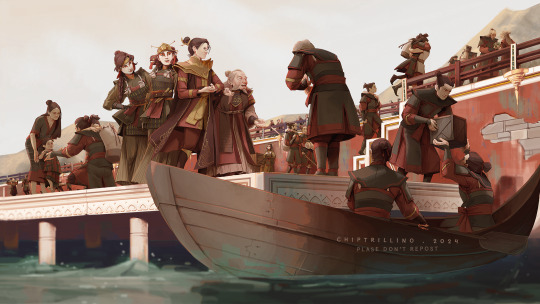
(ID in Alt Text)
A while ago I was invited to contribute to the Form the Ashes ATLA fan Zine for @recovery-zine!
I got to illustrate this double spread! (which was terrifying, thank you)
Pretty sure this is where the thought "Jee survived the north" began to form for me! The theme was about the war ending, peace settling and people getting to come home and reunite with loved ones.
4K notes
·
View notes
Text
[ID: Chief arnook's palace juxtaposed with a gopuram, a drawing of Wanshitong's library juxtaposed with the taj mahal. End ID.]
South Asian and Hindu Influences in ATLA (Part 1)
disclaimer: i was raised culturally and religiously hindu, and though i've tried to do my research for this post and pair it with my own cultural knowledge, i'm not an expert on hinduism by any means. should i mess up, please let me know.
please also be aware that many of the concepts discussed in this post overlap heavily with religions such as buddhism and jainism, which might have different interpretations and representations. as i'm not from those religions or cultures, i don't want to speak on them, but if anyone with that knowledge wishes to add on, please feel free.
it's well-known that atla draws from indigenous, east and southeast asian influences, but something i rarely see discussed in the fandom is the influences the show takes from hinduism and south asia, and there are actually far more than i think people are aware of.
so here's a (non-exhaustive list) of the main inspirations atla drew from south asian culture and hinduism, starting with...
The Avatar
the title of the show itself is taken from the ancient language of sanskrit, often considered the sacred tongue of the hindu religion. in sanskrit, the word "avatar" means to "descend" or "alight".
the concept of the avatar is a very old one, referring to the physical incarnation of a powerful deity or spirit. the idea of the avatar is most often linked to the god Vishnu, one of three supreme hindu gods collectively called the trimurti, or trinity. the avatar is said to manifest upon earth primarily in times of great need, when balance must be maintained between the forces of good and evil.
atla borrows heavily from this idea in having aang be the incarnation of a divine spirit who returns to the world during a time of immense strife, and is tasked with defeating a great evil to bring balance back to the world. and though i don't know if it was an intentional reference, it's interesting to note that Krishna, the most famous incarnation of Vishnu was also reborn amidst a fierce storm and carried through a raging sea to a new home where he would be protected from the king who sought to kill him. sounds a little familiar, doesn't it?
Agni Kai and the Philosophy of Firebending
the word "agni" derives from the sanskrit name Agni, the god of fire, though it can also generally mean "fire".
the concepts of lightning bending and the sun being the source of firebending are likely also taken from the idea of Agni, since he's said to exist simultaneously in three different forms on three different dimensions: as fire on earth, as lightning in the atmosphere, and as the sun in the sky.
Agni is a significant aspect of many rituals, including marriage rites, death rites, and the festivals of holi and diwali. the concept of Agni is one of duality: life and death, rebirth and destruction. hindu rituals accept and celebrate both aspects, revolving around the idea that destruction is not separate from creation, but rather necessary to facilitate it. the cremation of the dead, for instance, is seen as purification, not destruction: burning away the physical form so the soul is unencumbered, set free to continue the reincarnation cycle.
this influence can be seen in the firebending masters episode, which discusses the idea of fire being vital to life. the sun warriors safeguarding the original fire and demanding that zuko and aang bring fire to the dragons as a sacrifice could also reference the ritual of Agnihotra - the ritual of keeping a fire at the home hearth and making offerings to it. the purpose of this ritual differs depending on which text you refer to, but it is generally believed to purify the person and atmosphere in which it is performed, similar to how zuko and aang must make offerings to ran and shaw and survive their fire before being deemed worthy and pure.
Agnihotra is said to serve as a symbolic reminder of the vitality and importance of fire as the driving force of life, a lesson that zuko and aang also internalize from their encounter with the dragons.
Bumi
bumi's name is taken from the sanskrit word "bhumi", which means "earth". it's also the name of the hindu goddess of the earth, bumi or bhudevi.
one of the things the original animation didn't do and which i really enjoyed about the live action was that they made bumi indian and added desi inspiration to omashu. it makes perfect sense for a king whose name is as hindu-inspired as they come.
NWT Royal Palace
chief arnook's palace in the northern water tribe takes inspiration from the gopurams of hindu temples, massive pyramidal structures that served as entrance towers to the temple.
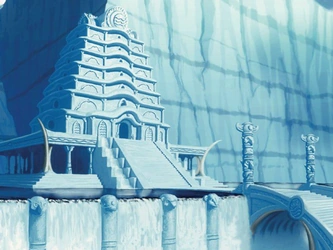

gopurams were built tall enough to be seen for miles around, beacons to signal tired or weary travellers who wished for a place to rest that a temple was nearby. it's a nice touch that the chief's palace is located in front of the spirit oasis, a similarly symbolic entryway to a sanctuary housing otherworldly deities.
Betrothal Necklaces
to preface: i doubt this was an intentional reference, and this great post talks about other cultures that could have inspired the water tribe betrothal necklaces. given the desi influence in the nwt architecture however, i figured it was worth mentioning.
the idea of betrothal necklaces being given to women by their male partners is similar to the thaali, a necklace given to hindu wives by their husbands. during hindu weddings, grooms tie the thaali around their brides' necks to symbolize their marriage. once given, wives are expected to wear their thaali till the day they die, as doing so is believed to bring good luck, health and prosperity to their husbands.
Chi-Blocking
though chi-blocking takes primary inspiration from the art of Dim Mak, it is also influenced by the south indian martial arts forms of adimurai and kalaripayattu, both of which include techniques of striking vital points in the body to disable or kill an opponent.
kalaripayattu also shares parallels with firebending, being a very physically demanding, aggressive martial art that emphasises the importance of discipline and mental fortitude. control of the mind is essential to control of the body, a philosophy similar to that espoused by iroh across the show.
Wan Shi Tong's Library
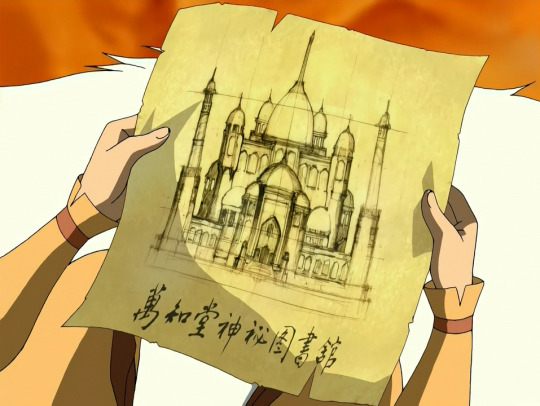
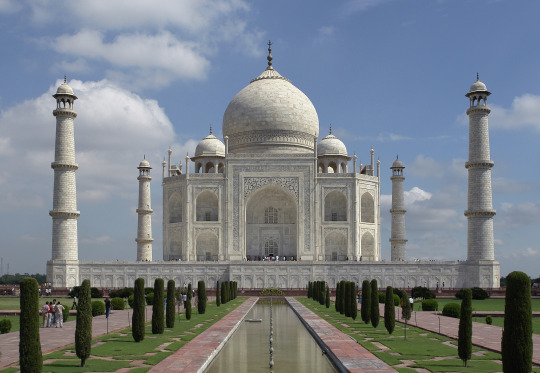
the library draws inspiration partly from the taj mahal, the famous mausoleum constructed by shah jahan during the mughal empire as a monument to his beloved wife, mumtaz mahal.
i'll end this post here since it's getting too long as it is, and the following section will be even longer. for while atla treated the concepts in this post with respect, the same unfortunately cannot be said for its depiction of guru pathik and combustion man - both of which we'll be discussing next.
764 notes
·
View notes
Note
Just popping by to say that 'Wanyi' and your words for why it's a good name for Zuko's ship hit me like a sack of bricks to the chest. absolutely incredible choice, I am REELING.
I'm glad you found it so touching!
I haven’t read Embers. I thought MuffinLance intentionally named Zuko’s warship 萬一 (one in ten thousand, what if) from the start. It’s been a bit bewildering to see a mistake become new fanon.
At risk of ruining the sentimentality of the name Wanyi, I would issue a few caveats to people adopting it for their fics. It’s really more of a retrofit of the old name—something to rebrand while sounding and looking similar enough to Wani to not be distracting.
Wanyi is pinyin romanization, used in the People’s Republic of China. You could just as easily spell it Wan-i or Wani. Canon uses a mix of romanization methods. However, if the goal is rebranding, Wanyi makes sense.
Wanyi isn’t an Authentic™ historical Chinese boat name. That would be something like Galloping Clouds or Tranquil Seas.
You might want to use a different culture instead of Chinese for Zuko’s warship. Canonically, there are Fire Nation characters with Chinese inspired names, like Zhao, Piandao, and Shyu, but if your fan-fiction is drawing more inspiration from Japanese or Thai culture, maybe a different name is more suited.
Wanyi is often used for negative what-ifs. An unlikely disaster. Zuko is, after all, a disaster magnet. And the cause of many misfortunes.
Wanyi literally means one in ten thousand, but it is grammatically used to indicate an extremely unlikely possibility. Like finding the avatar. To me, it feels ominous, anxious, yearning in an unrealistic sort of way, which I think all speak to Zuko's character arc. Idk, what do other Chinese speakers think?
#atla#avatar the last airbender#Wanyi#Wani#Ten-thousand is used to just mean something is countlessly large#One vs ten thousand = one vs an inconceivably big number#aka near-impossible#The library spirit Wanshitong’s name is translated as “he who knows ten thousand things” but it also just means “he who knows everything.”#Yeah it’s not authentic but canon is pretty fast and loose with authenticity the forest is just named Senlin (Chinese for forest)
302 notes
·
View notes
Text
“You’re cheating!”
“No I’m not, you’re just bad at it.”
Podfic of @a-witch-in-endor's Fire Sage Zuko AU: Chapter 10
In which Zuko and Sokka bond in a Northern Water Tribe prison.
#atla#avatar the last airbender#a witch in endor#while mighty oaks do fall#atla fanfic#podfic#fire sage zuko#zukka#please enjoy this tooth rotting fluff
172 notes
·
View notes
Text
culture tips for writing asian settings: calligraphy
i love chinese calligraphy, to me it is just so gorgeous and i've dedicated a few scenes of my own fics to it, so here are just a few quick 'n' dirty calligraphy tips:

the calligraphy scene in sokka's master (illustrated by korean animators!) is a pretty good depiction tbh. you write using a brush (the brushes can be hung up on a stand too)—it can be jarring to see fics mention quills or parchment. one excellent detail from the show is that sokka, who seems left-handed, has to write with his right hand—the left hand holds the sleeve out of the way. the ink is not liquid/bottled, but is in a solid stick form and has to be ground on an inkstone mixed with water

traditionally, chinese text is written downwards, and goes from right to left across the page.
as with any other form of calligraphy, chinese calligraphy emphasises beauty of form over legibility—in the same way you wouldn't really consider times new roman font 'calligraphy'. there are different types of script in chinese, and for someone like piandao to master them is a reflection of his education and gentility. the semi-cursive below i see quite commonly in calligraphy:
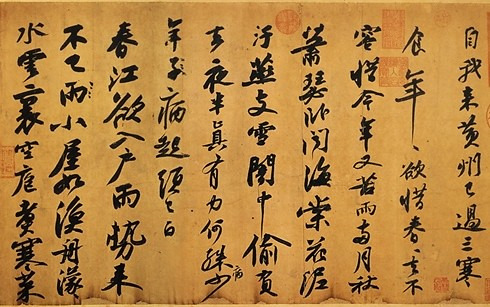
then you might have something like the cursive below is quite technical but seriously hard to read

contrast that with something like this seal script, harking back to an older era of chinese script:

any calligrapher worth their salt will be putting their stamp on the work, quite literally! name seals, also called "chops", are carved out of stone; ink it up with cinnabar paste and stamp it onto your artwork to get that iconic red signature. (i got one made a couple of years ago and there's a trick to stamping: breathe on the stamp surface after dipping in the paste to warm up the pigment, and when stamping put some circular pressure on the stone to get the print to come out evenly)
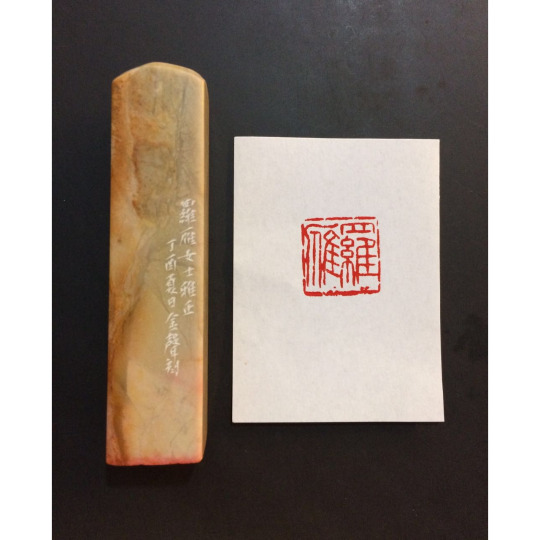
check out:
some more calligraphy examples from singapore's national gallery
disclaimer | more tips
661 notes
·
View notes
Note
[ID: a red lily]
Chinese Ideas for Fire Nation Names
I wouldn’t recommend using 妹 mèi. Chinese tends to use family names as informal titles. For example, in English you’d call a stranger Miss Li, but in Chinese you could call them “sister Li” It’s very generic sounding. Also, there's already a Fire Nation character with the same name pronunciation but a different spelling (Mai). Mèilì is a homophone with 魅力 meaning "charisma."
Here are some ideas of Chinese characters that I think fit the Fire Nation. Some of them are rare characters like 炟 Dá: ignite, I just like them. (Note I'm using traditional characters)
Militant names:
偉 Wěi: Great
勇 Yǒng: Brave
軍 Jūn: Army
Firey names:
燁 Yè: Blaze of fire/glorious
爍 Shuò: Lumious
熒 Yíng: Glimmer/twinkling
炘 Xīn: mid-day glare of the sun
焮 Xìn: flame
炫 Xuàn: dazzle
炣 Kě: literary word for fire
煒 Wěi: Glowing
熠 Yì: Glow/flash
炟 Dá: ignite
Sunlight names:
明 Míng: Bright/wise
亮 Liàng: shine
霞 Xiá: rosy colored clouds at dawn and dusk (my personal favorite)
耀 Yào: shining/glorious
輝 Huī: to shine on/splendor
晨 Chén: dawn
光 Guāng: light
曦 Xī: Sunlight (usually at dawn)
晗 Hán: before daybreak
昭 Zhāo: Bright/to show clearly (maybe avoid because it sounds too much like commander Zhao. I headcanon that his name uses the character 趙 Zhào meaning “to surpass”)
曉 Xiǎo: Dawn (maybe don’t use this though because it also sounds like 小 xiǎo “little” which is a typical diminutive)
暖 Nuǎn: warm
旭 Xù: rising sun
You’ll notice a lot of these characters have the radical component for fire 火 or sun 日.
Name structure:
Historical (and some contemporary) names sometimes follow a 3 character structure of [family name]-[generation name]-[given name]. The family name is passed down the father’s line, the generation name is shared by siblings and cousins, and the given name is unique. So if your name is Cai Yuxiu, maybe your sisters’ names would be Cai Yuting and Cai Yufang. Naming people after other people is rare (and, in cases of royalty, was highly illegal), so no naming people Ozai lol. Canon ignores that though: Azula is named after her grandfather Azulon. It's a fantasy setting, not a 1-to-1 cultural equivalent.
2 Character names:
Like @ranilla-bean mentioned in the comments, 2 character names tend not to just be 1 concept, but 2 ideas put together to have a larger meaning, like:
建國 Jiànguó: nation building
強國 Qiángguó: Strong nation
晨迎 Chényíng: [dawn][welcome], welcoming the dawn or forging ahead at dawn
皓萱 Hàoxuān: [bright][orange day lily]
寧霞 Níngxiá: peaceful rosy colored clouds
About 麗 Lì:
麗 Lì (丽 in simplified characters) "beautiful" is a pretty common character in women's names, but there are also a ton of other names that also are pronounced Li. And in the world of Avatar, there are a million Lis, like Ty Lee, the old ladies Lo and Li, and the little boy on the farm named Li. A Chinese speaker wouldn't necessarily know the meaning of the name Li unless the person goes to the effort of explaining it. "I'm Li. Li as in beautiful." It's pretty common to explain the characters of your name when you introduce yourself.
If you like 麗 Lì you can use it as-is or combine it with another character like 麗熒 Lìyíng “Beautiful glimmer” or 麗萱 Lìxuān "beautiful day-lily." Just do a quick Google search to see if other people with the name come up. Sometimes word combos can form a homophone with something offensive so tread carefully.
Searching for names:
To do Google searches for names you can copy the following:
帶[X]字的女孩名字: Girl names with the character[X]
帶[X]字旁的女孩名字: Girl names with the radical component [X] (put whatever component you want here, like fire 火, sun 日, water 水,earth 土)
Since you know some Chinese, you can probably use a cursor dictionary like Zhongwen Chinese popup dictionary to parse through the names and pick something you like!
Pronunciation:
Some Chinese names are hard to pronounce, especially ones with a Zh or X in them. If you want to go easy on non-Chinese speakers, pick something simple. Or pick whatever you like and have it be an educational moment! You can even link a pronunciation guide in the footnotes to be extra pedantic.
Caveats:
I do translation, but my native language is English. If you have a Chinese speaking friend you can check with, definitely do so. You don't have to go with an especially firey name. Someone from Jang Hui might have a more water inspired name like 珊 Shān: Coral. Also, the Fire Nation gets a lot of cultural inspiration from Southeast Asia and Japan. You could search for Thai names?
hi:) I have a question and its a long shot that you could answer it but maybe you know where I should ask? I'm making a fire nation character and I wanted to give her a real Chinese name. I know a little bit of Chinese but not enough to know if a name is weird-sounding or not (to someone fluent). I was thinking about the name mei4 li4 妹丽, which I do believe is a real name but the character Mei instead of the character meaning beautiful it is little sister (same-ish sound)
When it comes to giving characters Chinese names, I think this post by Fine I'll Sign Up is a great starting point.
I'll give my two cents but please take it with a grain of salt as I'm nowhere close to being an expert on Chinese names. That said, I think the name "beautiful little sister" sounds a bit strange. I know that "little sister" can be used colloquially to refer to any young woman, but it doesn't sound like a name that a parent would give their child.
After all, your daughter isn't going to be a young woman her whole life, so you don't want to give her a name that'll start sounding odd once she hits middle age. More realistically, if you want your character's name to reflect a sweet and innocent personality, the name should allude to something poetic that symbolizes those qualities.
If I may make a recommendation, how about naming your character Bǎihé (百合)--- Lily? According to a few floriography websites, the Lily can represent purity in Chinese culture. It also represents a long-lasting marriage, which is the sort of thing traditional parents would want for their daughter. Plus, the Fire Nation is known for its beautiful fire lilies.

276 notes
·
View notes
Note
Hi! I'm thinking about making a podfic of one of my favorite fics and I wanted to ask for a couple of tips because I adore your podfics and I have run into a couple problems very early on.
how do you do deeper voices? my voice is fairly high (I'm a soprano that can occasionally deep down into lower alto) and most of the voices in the fic are male. I also always sound about twelve in recordings lol
how do you make distinct voices? again, I have a lot of different voices (probably 5-7 that talk the most, with many many other reoccurring characters).
pacing of reading. I tend to speak/read very quick and in my practice recordings, it sounds like I'm talking much faster than I felt I was. any tips on that?
what recording programs are best? currently I'm using voice memos on my phone. which. is clearly not going to give me the best sound, regardless of the app I use, but I don't have many options.
I am living in a dorm right now and live in fear of my suite mates hearing me (my roommate not quite as much as she likes to dub and does a lot in our room--though she does it in mandarin so I cant understand it). not to mention background noise of doors opening and whatnot. if you have any tips on that as well, that would be great!
I love your podfic, you put so much soul into them, and I hope that I could do that too!
Hello fellow podfic-er! I’m so excited for you to make a podfic!
The nice thing about podfics is that I usually don’t have to create characters from scratch, they already exist in the TV show. If I’m struggling with a character, I just rewatch some clips of them talking and imitate it!
Deep voices: I, too, have a high, childish voice and struggle with deep, Manly Men. I guess the main tip I have is to...give up. What I mean is focus less on pitch and more on tone. If you speak too low, it’ll be less expressive and will probably hurt your throat. It can work for minor, 2D characters, but don’t do it for main characters that have a wide range of emotions (you may notice that my Mighty Oaks Fire Sage Zuko voice swings higher when he’s emotional oops). Instead, use your normal pitch, and make a character sound adult by using an authoritative tone. Another thing I do is play up the childish and feminine voices. We might not be able to make the adults sound adult, but we can make the kids sound extra kiddish by comparison.
Distinct voices: I’m a tactile learner, so for me, it’s all about the physicality. Every time I do Azula’s voice, I make a pinched face like I’m eating a lemon. When I record Ozai, I sneer. For Sokka, I jut out my chin and flail my arms. It looks silly, but no one is around to see. There’s lots of YouTube tutorials about how to make different voices by varying speed and tone and nasal quality, but I get kinda lost in the sauce with those theory lessons. The only way I can really get myself to do different voices is if I’m working off of a reference. I just watch videos of other cartoons and live actors and then copy them.
Pacing: Pacing is hard. I especially struggle with the editing and often end up cutting things wonkily. Audiobooks tend to be slow because you’re less likely to get tongue tied that way. If I have a big hunk of text that I find myself racing through, I slow myself down with physicality again. I’ll lean in on important words or mime out the actions. For example, on the line, “Zuko turns, grabs the bar at the side of the ship, and throws himself back over,” I'll turn my body on the word “turn,” grab an imaginary bar on the word “grab” and then lurch forward on the word “throw.” Adding in movement can bring variation to those big blocks of text.
What recording programs are best: I don’t know! I use Audacity because it’s free. Adobe Audition is great too, but it’s expensive. I am very lazy with the podfics. I don’t have a professional set-up. Basically, I make a comfortable nest of pillows in bed or my closet, use an iPhone VoiceMemos app to record straight into the phone mic, send the audio file to my computer, convert the audio to a WAV file, put it in Audacity, add a Noise Reduction effect, and then cut it down. Once I’m done editing it, I export the Audacity file as an mp3, upload it to archive.org and Spotify, and then embed those links into Ao3. Feel free to DM me if you have other tech questions. I am not particularly savvy, but we can Google it together? If any voice actors on Tumblr have professional advice, please chime in.
Silence and privacy: Background noise is a big headache for me too. I live in a noisy area with lots of planes and a squeaky elevator. I usually record now in my closet surrounded by pillows and blankets, so it’s fairly soundproof. If there’s a noise, I usually wait for the sound to stop, record the line again, then edit out the mistake in post. At the end of the day, though, sounds will slip in. It’s just a podfic; we’re doing this for fun not professionally, so it doesn’t need to be polished. I think most listeners’ attitudes is that something is better than nothing. If you’re in a school dorm, there might be music practice rooms, a radio recording booth, or empty classrooms you can use instead.
Storage: Something I didn’t realize going in was how much storage the audio clips take up. Make sure you save and delete projects as you go. One time I finished editing an Audacity project, but it wouldn’t let me save it because I ran out of storage and I had to start over.
I’m so glad you like the podfics I’ve done and that it could help inspire you to make one too! I started making podfics because I fell in love with @pixieinthesky’s fantastic Salvage podfic (it's an absolute gem). Keep the chain going!
Have fun!
50 notes
·
View notes
Text
[ID: Slightly larger than life-sized bronze statue of a bearded man. He has a realistic face and oversized, square shoulders and exaggerated, angular hands bigger than his face. There is an animal mask motif on his clothing. End ID]
As much as I adore this handsome statue, he’s not from the Shang dynasty!
He is a contemporary depiction of Cheng Tang (the founder of the Shang Dynasty) at the entrance of a Zhengzhou City Museum exhibit.
You can tell he's not from the Shang Dynasty a few ways:
The human depiction
Human depictions during the Shang dynasty are rare. People didn’t really make big shiny statues of their leaders all that much. Or if they did, the art didn’t survive to today.
A lot of the artwork that did survive from the Shang dynasty comes from graves, especially the tomb of Fu Hao (a military general and priestess). Most of the bronze artifacts found in graves are cauldrons and wine vessels; not human statues. Important people did have attendants accompany them to the afterlife, but instead of statues, real people and animals were sacrificed.
There are some depictions of humans, but they look like this (sighted folks, click the alt text for details about each piece):
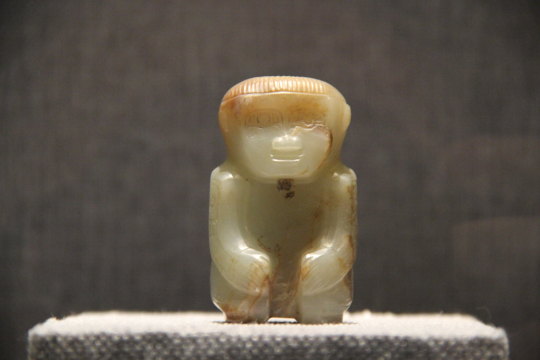

The casting method
Early Shang bronzes were cast in sectioned moulds. You’d carve the design you wanted into slabs of clay and then pour the bronze in. Then, you’d crack the mould sections off and reuse them to make matching sets. Sometimes people also added little decorative wings (flanges) to the seams.
Here’s a diorama from the Zhengzhou City Museum of what that might’ve looked like:
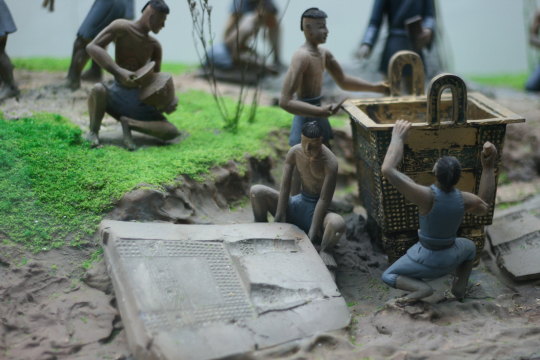
I think this handsome man was probably made with a hollow lost-wax method instead, which was used more in the later Shang and Zhou dynasty. The statue has finicky detailing like the ears that lost-wax is better at capturing. Also there’s no visible seams (though, to be fair, there are bronzes with perfectly concealed seams from the Shang dynasty). Disclaimer that I'm really not that well versed in casting techniques.
The art style
His face is quite realistic. You know the terra-cotta warriors from the Qin dynasty? His face is more reminiscent of that time period. Shang artwork is more abstract and geometric. Here’s some examples of animals with abstract detailing.

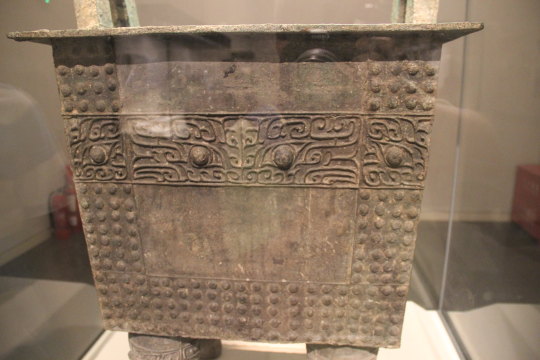
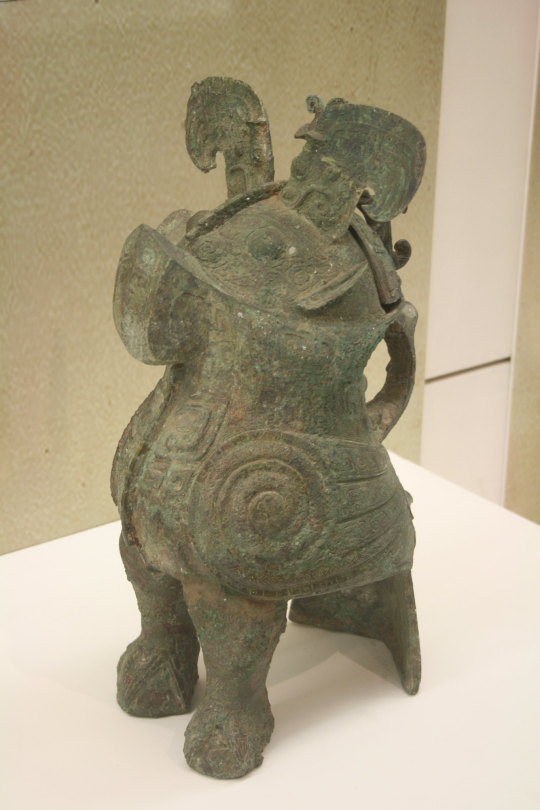
You caught me. This section was mostly just an excuse to show you some cool bronzes.
Also, the statue isn’t behind glass
Anyways.
I think this statue is really neat! His small head, oversized limbs, and flat dimensionality looks kind of like a Corporate Memphis art style...but with Shang motifs and coloring. The statue reminds me a bit of Ren Xiong’s self portrait from the Qing dynasty, which has an extremely realistic western-style face and expressive, abstract brushwork for his clothes. This statue's realistic face, combined with Shang and Zhou bronze patterns, intentionally oxidized coloring, and exaggerated, square proportions is a little bit jarring. Like he’s seesawing between old and new.
Sources
Big thank you to the Zhengzhou City Museum and the National Museum in Beijing for caring for these artifacts and to Professor Garry Lee Todd for taking all the photos in this reblog as well as the original post photo. He has hundreds of museum photo tours on his website.
Shang Jade Kneeling Person
Shang Jade Figure
Bronze Casting, Xingyang & Shang City
Shang Bronze Zun
Shang Bronze Ding
Shang Bronze Owl Zun

Bronze sculpture, China, Shang Dynasty circa 1600 - 1000 BC
Housed at the Zhengzhou City Museum
#shang dynasty#zhou dynasty#bronze#chinese art#Zhengzhou city museum#human sacrifice#Fu Hao#taotie#I am so sorry I'm like this#you've stumbled into a niche area of art history I love
2K notes
·
View notes
Text
I have a lot of resources and references on my blog alongside the aesthetics. But I wanted to highlight a few resources in particular here for those who don't feel like going through my tags.
For the Casual Blogger or Generally Curious:
Why Write Image Descriptions?
How Screen Readers Read Content
How to censor words without messing it up for screen readers
Accessible Revamps (blog theme)
Accessible (3.0) (blog theme)
Accessibility-Related Google Chrome Extensions
How to make the colors on your mobile theme accessible
For Image, Video, and Audio Describers/Transcribers:
I see an image and want to describe it: a step by step guide
All About Image Descriptions (with lots of examples!)
People's Accessibility Discord Server Info Post
How to write an image description
Writing Alt Text
text alternatives are about the purpose of the image, not about every little detail
Guidelines for Creating Image Descriptions
Cooper Hewitt Guidelines for Image Description
Free Online OCR Website
OCR Space
a11ies.info
For Developers and Content Creators:
WebAIM
Dos and don'ts on designing for accessibility
How to Make Your Art Accessible
How to Make Your Stimboards Accessible
Making Your Games Accessible
Tips on making comics accessible
HTML Accessibility
Color Contrast Tools
How to Write Alt Text for Digital Comics
Accessibility in the Arts: A Promise and a Practice
Accessibility Options for Online Businesses
For Writers:
Making Your Blog More Accessible For Your Readers
Sensitivity Readers (blog)
Resources For Writing Deaf, Mute, or Blind Characters
Comprehensive guide to writing deaf characters
Tips on hearing aids and writing them
What is Legal Blindness?
Personal Accounts from Legally Blind People
Writing characters with one eye
Writing Blind Characters
Writing a Blind or Visually Impaired Character
A Characterisation/Writing Guide - Autism and ADHD
BPD videos
Disability in fanfiction: a few thoughts
Writing a disabled character who is frustrated with their limitations
Free resources for various sign languages
For Roleplayers:
Trimming Posts with XKit Rewritten
Writing Blind/Visually Impaired Characters in TTRPGs
Running RPGs with the Deaf and Hard-of Hearing
511 notes
·
View notes
Text
Another thing I forgot to mention!
荷 hé "lotus" is also a homophone with 合 hé "together." The lotus also symbolizes a future of working together with other nations rather than conquering them.
A quintuple meaning! Chinese is such a delightful language.
Also, I made something…
Figured that since Ozai looked so young in his portrait, that must mean it was made shortly after his coronation, or thereabouts, so applying that logic here, ZuZu stills looks young and handsome. The dragons, I know, that event was meant to be kept secret, but counter argument, this painting doesn’t necessarily say, “Hey, Dragons are still alive—here’s a map!” It’s just a bit of artsy-fartsy majestic embellishment. Also, I feel like Zuko might want to rebrand the Fire Nation, just a little, you know, after the 100 year war. So instead of just pure fire iconography, he brings things back to their roots, aka, the dragon. More dragon iconography!!! In this portrait, Zuko isn’t the one firebending, it’s the dragons, the first Firebenders. And in the meantime, he’s holding out a White Lotus. Now, I tried to use my Google Fu to find out if there was ever any symbol in Japan or Korea or China that meant “peace,” but my search results came up empty, so I figured that perhaps the lotus could become their version of, say, the olive branch. A discreet and tasteful way to include such a major part of the final battle while having a double meaning. Also, take note of the fact that he’s holding it with BOTH hands. In Japan, when one offers a gift, you always do so with both hands. And while I know it may look a little strange, Zuko towering over his friends—bro—this was always going to be Zuko’s Firelord portrait. He was always going to be the main focus. He just wanted to also include his friends and commemorate the day the war finally ended/his coronation. Anyway, that’s all for now… hope that wasn’t too much… and if anyone has any ideas for how to make it even better, pls let me know.
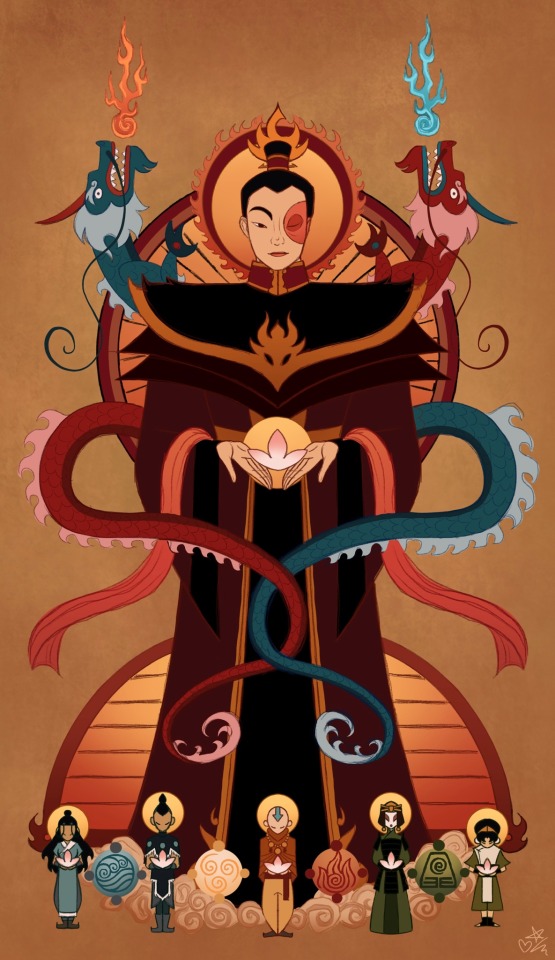
4K notes
·
View notes
Text
[ID: Full body portrait of Fire Lord Zuko in the style of the Fire Nation royal portraits. Zuko is holding a white lotus in both hands. Two dragons, one blue and one red, tendril their tails around him and breathe fire above each of his shoulders. In the foreground are 5 small figures of Katara, Sokka, Aang, Suki, and Toph, each holding white lotuses of their own, as well as the icons of Water, Air, Fire, and Earth. End ID]
In Chinese, the word "lotus" 荷 is a homophone with "harmony" 和. Both are pronounced hé.
The same character for lotus 荷 but pronounced with a down tone hè also means both the noun form for "burden" or "responsibility," as well as the verb "to carry a heavy responsibility." Very fitting for a Fire Lord shouldering the duty of restoring harmony.
Symbolically, lotuses typically represent resilience. Lotuses have roots in murky water but grow into something beautiful. There's actually an idiom about lotuses used to describe moral integrity: 出淤泥而不染 chū yú ní ér bù rǎn “to emerge from the mud untainted."
The perfect flower for Zuko.
Also, I made something…
Figured that since Ozai looked so young in his portrait, that must mean it was made shortly after his coronation, or thereabouts, so applying that logic here, ZuZu stills looks young and handsome. The dragons, I know, that event was meant to be kept secret, but counter argument, this painting doesn’t necessarily say, “Hey, Dragons are still alive—here’s a map!” It’s just a bit of artsy-fartsy majestic embellishment. Also, I feel like Zuko might want to rebrand the Fire Nation, just a little, you know, after the 100 year war. So instead of just pure fire iconography, he brings things back to their roots, aka, the dragon. More dragon iconography!!! In this portrait, Zuko isn’t the one firebending, it’s the dragons, the first Firebenders. And in the meantime, he’s holding out a White Lotus. Now, I tried to use my Google Fu to find out if there was ever any symbol in Japan or Korea or China that meant “peace,” but my search results came up empty, so I figured that perhaps the lotus could become their version of, say, the olive branch. A discreet and tasteful way to include such a major part of the final battle while having a double meaning. Also, take note of the fact that he’s holding it with BOTH hands. In Japan, when one offers a gift, you always do so with both hands. And while I know it may look a little strange, Zuko towering over his friends—bro—this was always going to be Zuko’s Firelord portrait. He was always going to be the main focus. He just wanted to also include his friends and commemorate the day the war finally ended/his coronation. Anyway, that’s all for now… hope that wasn’t too much… and if anyone has any ideas for how to make it even better, pls let me know.

4K notes
·
View notes
Text
“This is great. Walking into enemy territory. With paperwork."
Podfic of @a-witch-in-endor's Fire Sage Zuko AU: Chapter 9
In which Zuko subtly eviscerates a war minister.
#atla#avatar the last airbender#podfic#fire sage zuko#while mighty oaks do fall#a witch in endor#silly hat zuko#zuko#fanfic
42 notes
·
View notes
Text
[Image ID: Avatar intro screen with calligraphy that says 气和 with the caption "Air (is) Harmonious. End ID]
Firebending Chi: Breath vs Anger
Excessive chi or “air” is also used to represent anger in Chinese!
Examples:
生气 give birth/grow air = angry
气炸 [fill with] air and explode = burst with rage
气死我了!I'm so [full of] air I'm gonna die! = I'm furious!
我故意气他一下 I’m going to go [fill him up with] air on purpose = I’m gonna piss him off.
我很气tuktukpodfics总是宣扬自己对中文语言学的高见: I'm so [blown up with] air (annoyed) by how tuktukpodfics is always pontificating about Chinese linguistics.
You can visualize the metaphor as a person inflating, about to pop. English has some parallel metaphors, like "blowing ones top off." People also “vent” or “blow off steam” to calm down.
I think it's interesting that the Fire Nation has a whole conflict about whether firebending comes from the breath versus anger when the Chinese concepts overlap.
Why Air is the “Spiritual” Element
As promised, the Air Nomad cultural analysis that won the survey. Get comfortable, because it’s a rather lengthy post.

We’re all familiar with that iconic Avatar opening: Four masters bending their respective element in front of two Chinese characters. The characters used to represent the “culture” of air are “气和”, with “气” meaning “air” and “和” meaning “harmonious”. Literally telling the audience, “Air is Harmonious”. This is all very appropriate, as the Air Nomads were pacifists.
However, I’d like to focus on the specific character “气”, because it carries so much more metaphysical weight in Chinese culture than simply being another word for “oxygen” or “gas”. “气” is pronounced “chi”. And yes, this is the same chi we hear mentioned constantly throughout Avatar. Chi does literally mean “air”, but that conception of air also encompasses breath, life energy, and spirit.
This is why the Air Nomads were portrayed as deeply spiritual and universally benders. A lifestyle dedicated to understanding the spirit is synonymous with understanding the qualities of air. Because, in this world based heavily in traditional Chinese culture, your spirit is interconnected with the air and energy around you; which ties in nicely with the Avatar State and just about everything Guru Pathik tells Aang.
This also helps to explain why Aang mastered energybending so quickly. The energy in energybending likely refers to the same “气” that also encompasses air. So while I do take some issues with how airbending was handled in Legend of Korra, I will say that the spiritual projection that Jinora does actually makes some sense when you consider that “气” can mean both air and spirit.
And, for anyone wondering, the more scientific and literal word for air in Chinese is “空气”. The decision to write “air” simply as “气” was a purposeful choice to add to the ancient and mythic quality of the series.
2K notes
·
View notes
Text
If you are a poor soul who cannot sleep without your bedtime fanfiction in these trying times, may I offer a subtle reminder that the stories I've recorded are available on Spotify and also the Internet Archive (though there are some drafts in there too so, uh, just ignore those please)
34 notes
·
View notes
Text
Podfic of @a-witch-in-endor's Fire Sage Zuko AU: Chapter 8
In which Aang's heart is broken.
#atla#avatar the last airbender#podfic#fire sage zuko#a witch in endor#silly hat zuko#while mighty oaks do fall#zuko#fanfic
47 notes
·
View notes
Text
[Image ID: 4 photos in a grid. Screenshot of the banyan-grove tree's aerial hanging roots juxtaposed with a photo of a real banyan tree's hanging roots. Screenshot of the banyan-grove's gnarly ground roots juxtaposed with a photo of real mangrove roots. End ID]
Cultural Practices: Banyan-Grove Tree Pt. 1

The Foggy Swamp’s banyan-grove tree is hybrid of a banyan tree and a mangrove tree; the banyan aspect stems from the aerial roots descending from its branches, while the mangrove aspect stems from its ability to thrive in a wetland environment. Both trees are also native to Vietnam, which was a huge inspiration for the Foggy Swamp and its surrounding areas.
@tuktukpodfics did an amazing analysis of the banyan-tree’s ecological symbolism, so I won’t go any more in-depth into the botany of these plants.
The banyan tree is significant in Buddhism, Hinduism, and Vietnamese culture. In Buddhism, Siddhartha Gautama (the Buddha) achieved enlightenment after meditating under a type of banyan tree; this is even referenced in the episode by Huu, who reached enlightenment the exact same way. Fun fact: The banyan species that the Buddha meditates under is colloquially known as “bodhi trees”, due to their cultural significance.
In Hindu culture, the tree is believed to attract ghosts and is often planted near crematoriums. This is because the tree simultaneously symbolizes immortality and death. The tree itself is perceived as immortal due to its many deeply ingrained and expansive roots. At the same time, where ever the tree grows, no other plant life can live. In other words, Immortality + Death = Ghosts.
These cultural undertones are why the Foggy Swamp inspires both great wisdom and fear within those who visit it. Similarly, this is also why banyan trees are so prominent in the spirit world. They’re basically the embodiment of the spirit world.
In Part 2, I’ll discuss the banyan tree’s significance in Vietnamese culture.
273 notes
·
View notes
Photo
[Belated image description: Avatar the Last Airbender spirit Wanshitong looming over Zuko]
😮 a dream come true 💕

Fanart for this fanfiction: https://archiveofourown.org/works/24590470?view_full_work=true
92 notes
·
View notes